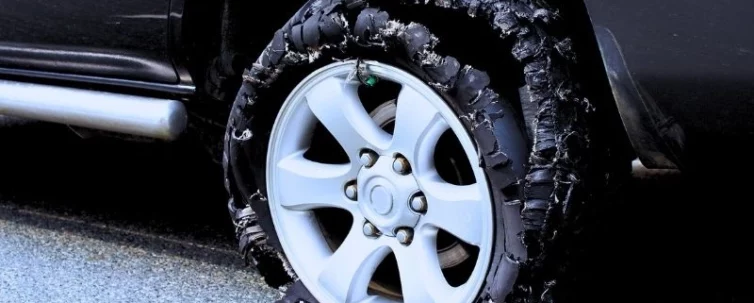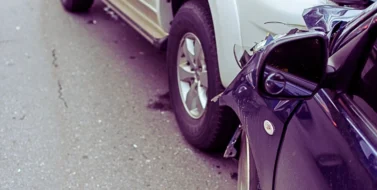As the victim of a crash involving a tire failure, you might be wondering, “Is a tire blowout an at-fault accident?” The short answer is yes. When a tire blowout causes an accident, it is usually a result of some type of negligence. In Illinois, and especially in urban areas like Chicago where road hazards are common, determining liability in a tire blowout accident isn’t always straightforward, however. Tire blowouts can be triggered by defective manufacturing, improper maintenance, road debris, or even extreme weather—factors that may or may not point the finger at the driver.

At Lloyd Miller Law Group in Chicago, we help injured victims cut through the confusion insurance companies rely on to minimize payouts. If you were hurt in a blowout-related accident, or you’re being unfairly blamed for one, we can help you understand your rights and fight for the compensation you deserve.
Table of Contents
Who’s at Fault in a Tire Blowout Crash?
In Illinois, fault in a car accident comes down to negligence. If a tire blowout leads to a crash, liability will depend on whether someone failed to act with reasonable care. That might be the driver, a mechanic, a tire shop, or even the manufacturer.
To hold a party legally responsible, your car accident lawyer will need to prove:
- A duty of care was owed to you.
- That duty was breached through negligent actions or omissions.
- The breach caused the blowout and resulting accident.
- You suffered documented damages as a result.
Common Liable Parties in Tire Blowout Accidents
In tire blowout cases, numerous parties may be liable for damages.
1. The Driver of the Vehicle
Drivers are expected to inspect and maintain their vehicles, including tire pressure, tread depth, and signs of wear. If a motorist ignored obvious signs of tire damage or failed to replace aging tires, they may be found at fault for the blowout and resulting crash.
2. Mechanic or Tire Shop
Improper tire installation, incorrect inflation, or failure to identify tire damage during routine service can make an auto shop or technician liable. If a recent service visit included tire work, your attorney will review those records for signs of negligence.
3. Tire Manufacturer or Distributor
Defective tires—especially those with manufacturing flaws or poor-quality materials—can lead to sudden blowouts. If a manufacturing defect caused the failure, you may have a strict product liability claim against the manufacturer or distributor.
Understanding Comparative Fault in Illinois Tire Blowout Cases
In many accident cases involving tire blowouts, more than one party is found to have contributed to the crash. When that happens, Illinois uses the modified comparative negligence rule. Injured victims who are less than 51% at fault for their accident can recover compensation in a personal injury lawsuit, but their settlement or jury award will be reduced according to the percentage of fault assigned.
For instance, if you were determined to be 10% at fault in an accident involving a blowout that was mainly caused by a defective tire, you would receive compensation for 90% of your losses.
What Causes a Tire Blowout?
Determining what caused the blowout can help you and your attorney identify the liable parties. In most cases, tire blowouts are caused by preventable issues. More specifically, common causes include the following.
Underinflation
Driving on underinflated tires causes the sidewalls to flex more than they should, generating excess heat. This weakens the tire’s structure over time and increases the risk of a blowout—especially at high speeds.
Overloading the Vehicle
Exceeding the vehicle’s weight limit puts stress on the tires, making them more likely to fail. This is especially common with SUVs, trucks, and vehicles pulling trailers.
Worn or Aged Tires
Bald tires with little to no tread can’t handle heat or road hazards as well as new tires. Rubber also deteriorates with age, even if the tread looks fine.
Potholes and Road Debris
Chicago’s roads are notorious for potholes and sharp debris. Hitting these hazards at high speed can puncture or rupture a tire instantly.
High-Speed Driving
Excessive speed increases heat and friction, which can lead to tire failure—particularly if the tire is already compromised.
Manufacturing Defects
Sometimes the tire itself is flawed due to poor design, substandard materials, or production errors. In these cases, a product liability lawsuit may be filed against the manufacturer.
Improper Installation or Maintenance
Tires that are overinflated, mounted incorrectly, or serviced improperly are more prone to blowouts. This can make a mechanic or service center liable.
Proving Liability: The Role of Accident Reports and Evidence
In a tire blowout case, documentation is everything. Accident reports, witness statements, and professional vehicle inspections help paint a picture of what happened and why. If there’s a product defect or service error, your lawyer may bring in expert witnesses to testify.
Your legal team may also:
- Request maintenance logs from commercial vehicles
- Subpoena service history from tire shops
- Analyze tire remnants for signs of wear, puncture, or delamination
FAQ: Tire Blowout Accidents in Illinois
Is a tire blowout always considered the driver’s fault?
Not always. Fault depends on the cause. If poor maintenance led to the blowout, the driver could be liable. But if the tire was defective or installed incorrectly, other parties may be at fault.
Can I sue a tire manufacturer for a blowout?
Yes, if the tire was defective. Illinois allows product liability claims for design defects, manufacturing errors, or inadequate warnings.
What if the tire blowout was caused by road debris?
Liability could fall on a third party (e.g., a commercial vehicle that dropped debris). A lawyer can help investigate the source and determine fault.





